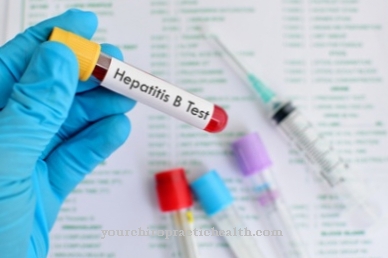Simvastatin is a classic statin and is used as a cholesterol-lowering drug. It was approved in 1990 and is used relatively frequently.
What is simvastatin?
Simvastatin, chemical (1S, 3R, 7S, 8S, 8aR) -8- {2 - [(2R, 4R) -4-hydroxy-6-oxooxan-2-yl] ethyl} -3,7-dimethyl-1, 2,3,7,8,8a-hexahydronaphthalen-1-yl-2,2-dimethylbutanoate, is a drug that is mainly used as a cholesterol-lowering agent. Simvastatin is structurally derived from the naturally occurring monacolin K, also known as lovastatin.
Simvastatin is produced partially synthetically from lovastatin. Simvastatin was approved in Germany in 1990. The patent expired in 2003 - since then, in addition to the original product, numerous generic drugs have also been available on the market.
The molecular formula of simvastatin is C25H38O5. It belongs to the statins class of drugs and acts as an HMG-CoA reductase inhibitor. Simvastatin is in the solid state. The molar mass is 418.57 g x mol ^ -1. The melting point of the substance is 127 to 132 degrees Celsius. The lethal dose 50 (LD50) of the substance in rats after oral administration is 4438 mg kg ^ -1.
Pharmacological effect on the body and organs
As a classic representative of statins, simvastatin has a lowering effect on the cholesterol level in the blood, so it can be assigned to the cholesterol lowering drugs. This happens via an inhibition of the HMG-CoA reductase. This enzyme is responsible for the synthesis of cholesterol in the liver.
The enzyme is therefore of central importance in cholesterol biosynthesis. If the activity of the enzyme is inhibited, the cholesterol level drops because less new cholesterol can be synthesized.
In addition, an increased LDL receptor synthesis is brought about. As a result, more LDL cholesterol is stored in the liver. Through this storage, in turn, less LDL cholesterol reaches the periphery - so the cholesterol level in the blood continues to decrease.
Simvastatin is primarily metabolized by cytochrome P450 3A4. The metabolism therefore takes place in the liver. For this reason, drugs and foods that inhibit cytochrome 3A4 should be avoided as far as possible, as this slows down the breakdown of simvastatin, which in turn increases the risk of side effects. Cytochrome 3A4 is inhibited, for example, by clarithromycin, itraconazole, ketoconazole or grapefruit juice.
Medical application & use for treatment & prevention
As already mentioned, simvastatin is used medicinally as a cholesterol lowering agent. The use of simvastatin is indicated above all in the case of high cholesterol levels. Simvastatin is also used for acute coronary syndrome, unstable angina pectoris and heart attacks.
The term acute coronary syndrome does not denote a clear disease. The acute coronary syndrome is to be understood as a working diagnosis under which several cardiovascular diseases that cannot be distinguished clinically with certainty are summarized. These are namely unstable angina pectoris, a non-transmural infarction without ST elevation but with an increase in troponin T / 1, a transmural infarction with ST elevation in the fresh stage of the infarction and an increase in troponin T / 1, and sudden cardiac death.
Angina pectris ("chest tightness") describes a frequent, attack-like pain in the chest, which is triggered by a lack of blood supply (ischemia) to the heart. In unstable angina pectoris, the symptoms are not constant but change. However, there are no signs of a heart attack (myocardial infarction). Angina pectoris that occurs for the first time, angina pectoris in the first two weeks after a myocardial infarction and angina pectoris that occurs at rest are also described as unstable.
In myocardial infarction, heart muscle tissue is lost due to a local circulatory disorder. The reason for the local circulatory disorder is the reduction in diameter (lumen) of a branch of the coronary arteries.
Risks & side effects
Simvastatin can also cause side effects. These include non-specific headaches, an increase in liver enzymes, gastrointestinal complaints and toxic myopathies (muscle ailments without a neuronal cause) to rhabdomyolysis, the breakdown of muscles or muscle fibers. This side effect occurs mainly when gemfibrozil is given at the same time.
Simvastatin is contraindicated in cases of cholestasis (biliary stasis), elevated liver enzymes, myopathies, during pregnancy and breastfeeding, as well as hypersensitivity to one of the ingredients.
As mentioned earlier, simvastatin should not be taken with drugs or foods that inhibit cytochrome 3A4. In addition, simvastatin should not be given together with fibrates (e.g. gemfibrozil), as the risk of muscle damage is increased. The drugs Gemfibrozil, Ciclosporin and Danazol are contraindicated. The attending doctor can provide further information.



























